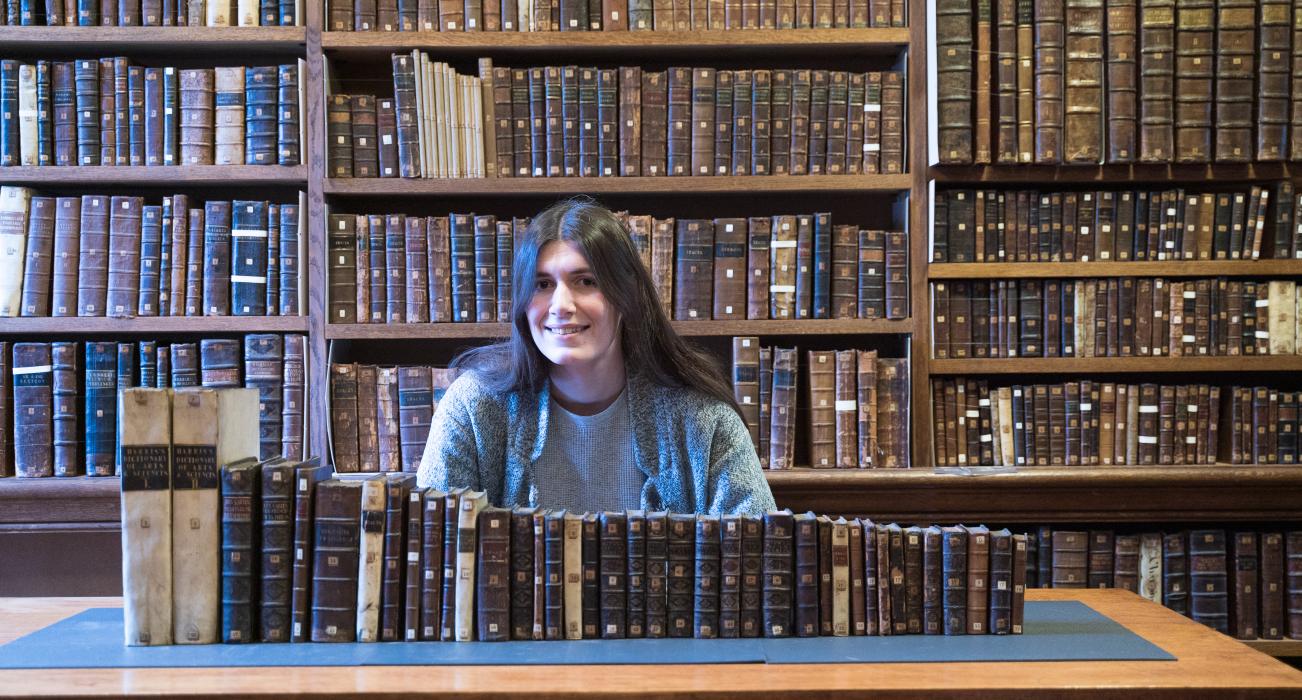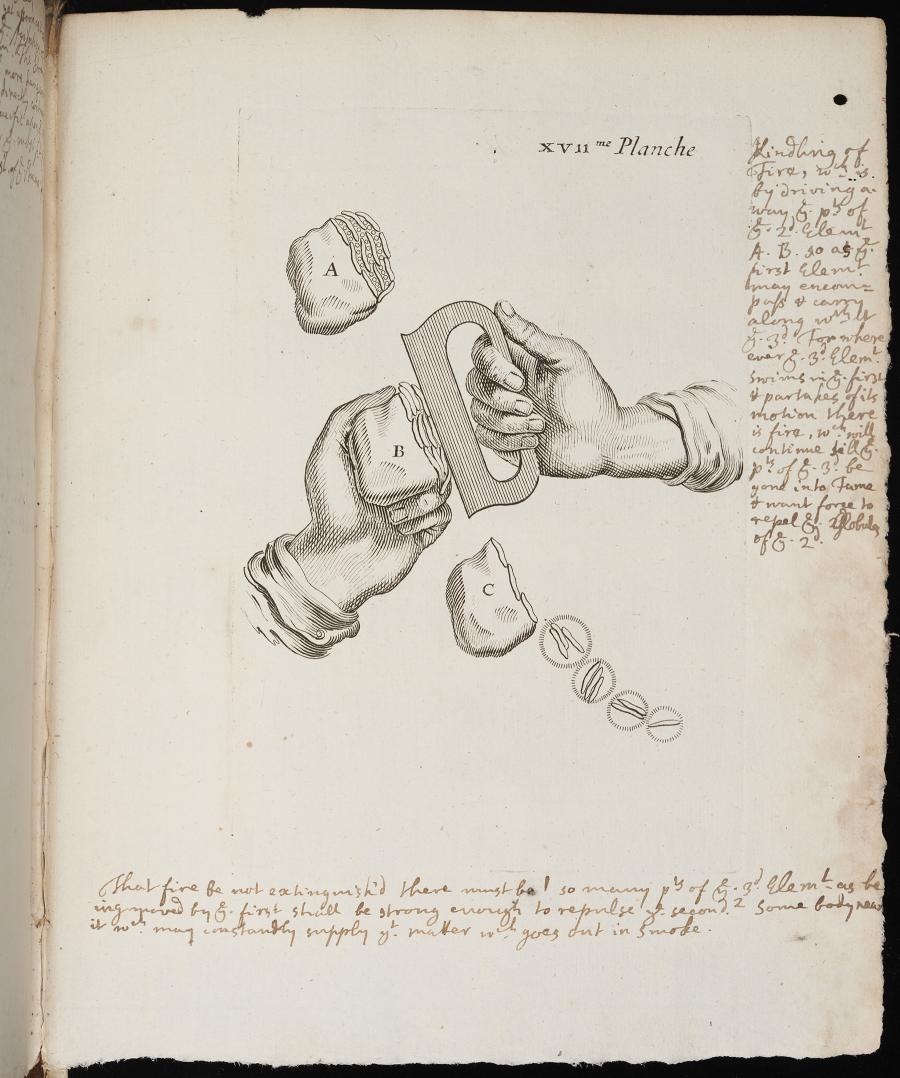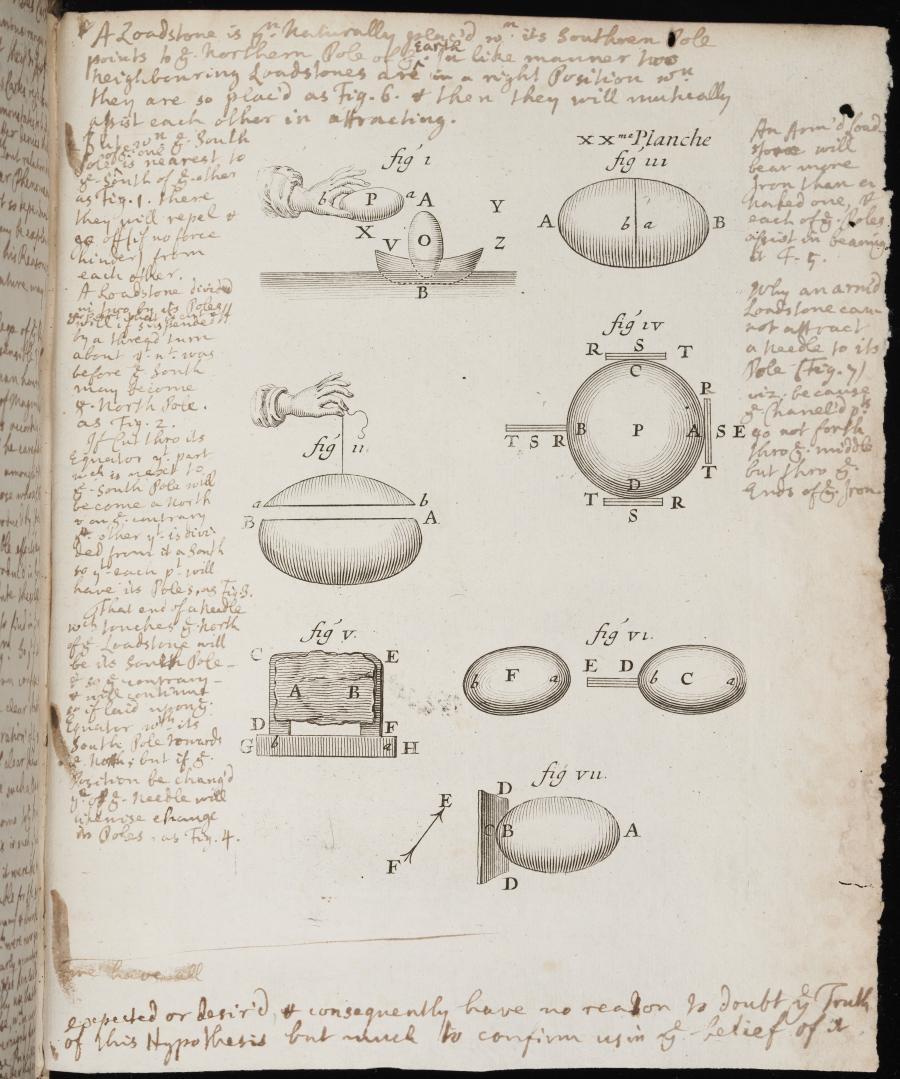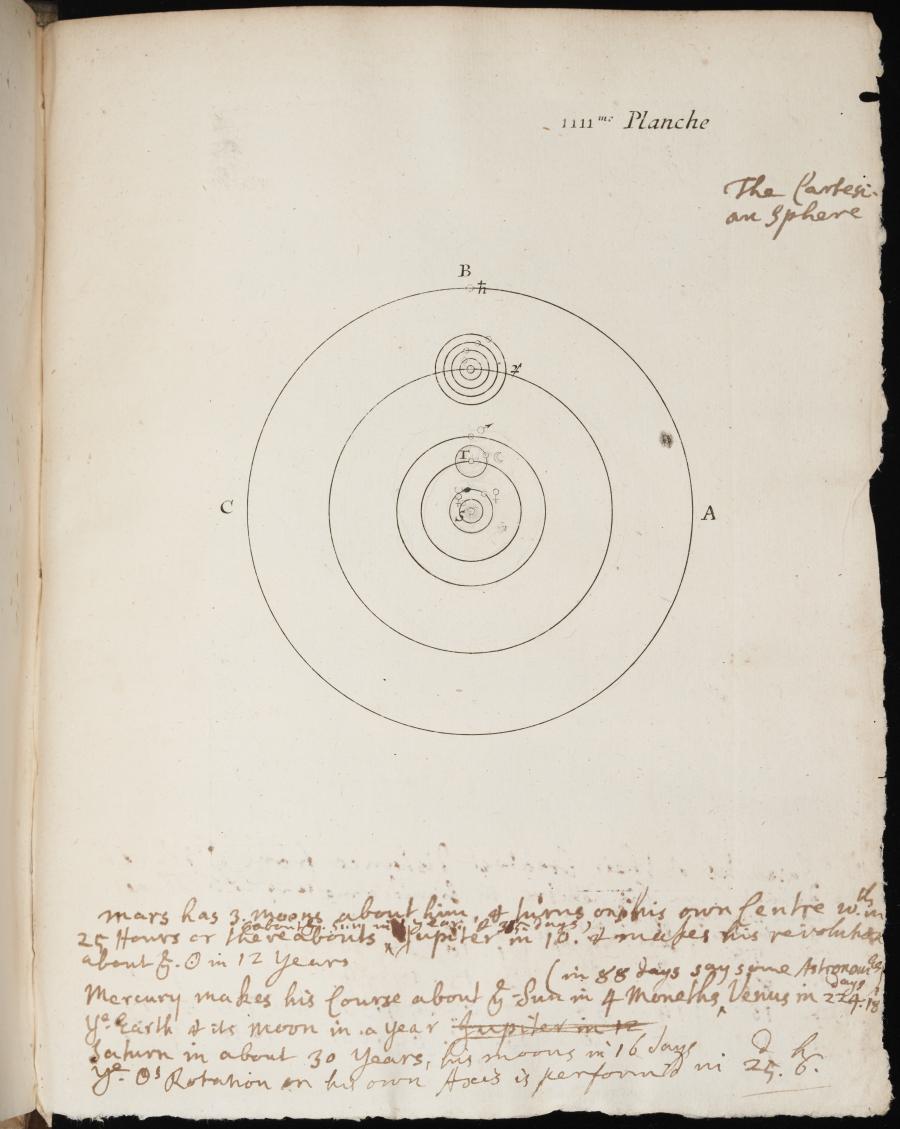Library discovery reveals a science student way ahead of her time
The astonishing collection comprises 47 books and pamphlets owned and annotated by the philosopher Mary Astell (1666–1731), viewed by many as “the first English feminist”. Her hand-written notes reveal, for the first time, that Astell engaged with complex natural philosophy including the ideas of René Descartes.
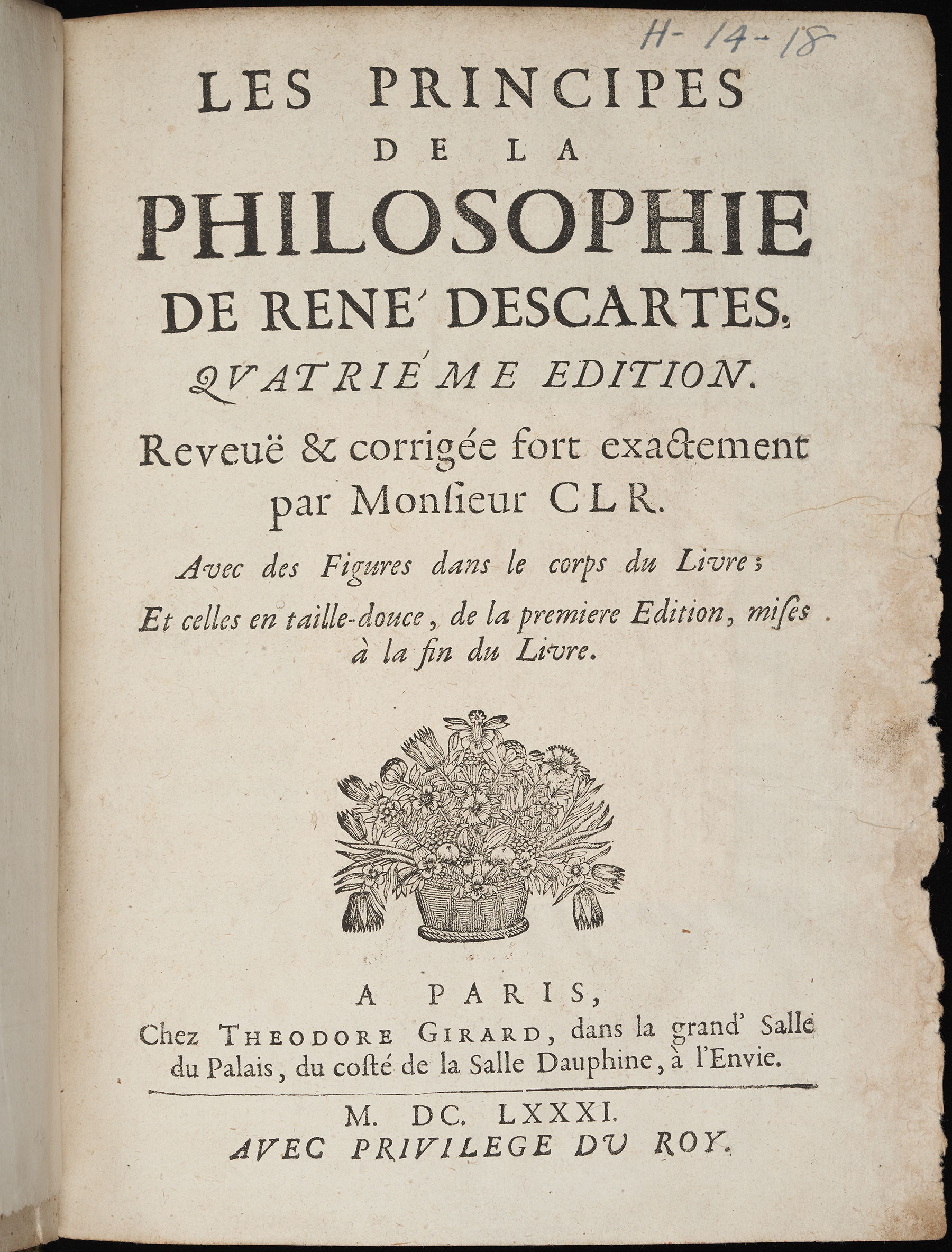
These are just some of the remarkable notes made by Mary Astell in her 1681 copy of Les Principes de la Philosophie, which set out René Descartes’ principles of nature, or laws of physics. In the early eighteenth century, only a minority of British women could read in English, let alone in French. But even more unusual is the extent of Astell’s scientific understanding which this precious collection makes clear.
‘Because ye Star sending out light from itself has ye greater force to continue its Rays in a right line, w[hi]ch makes it suffer ye less Refraction tho[ugh] ye diversity of ye medium be ye same.’
Catherine Sutherland, Deputy Librarian at Magdalene, who made the discovery says:
“Women’s book collections from this period are so rare but it’s even more amazing to find one being used to advance a woman’s career as a writer. Magdalene’s collection represents the nucleus of Astell’s library, including the books that influenced her most.”
![Because ye Star sending out light from itself has ye greater force to continue its Rays in a right line, w[hi]ch makes it suffer ye less Refraction tho[ugh] ye diversity of ye medium be ye same.](/sites/default/files/inline-images/H.14.18%20p.268_v2.jpg)
Sutherland found the collection during a recent provenance survey of Magdalene’s Old Library holdings, comprising around 8,500 books and manuscripts amassed by the college since its formation as a Benedictine hostel in 1428. Starting with books which presented the most explicit evidence of Astell’s ownership, Sutherland pieced together clues from bindings and citations in Astell’s published writings.
Sutherland says: “The old library is open to the public for an exhibition one morning a month and visitors pass through the room where Astell’s books live. But usually, access is by appointment only for visiting scholars and they mostly pre-order what they want to look at. So Astell’s collection has been hiding in plain sight really.”
Most scholarly interest in Astell has focussed on her philosophical thought and proto-feminism. Relatively little has been written about her book ownership because only a few survivors from her library were known about. These can be found at the British Library and the Northamptonshire Record Office.
“This is a major discovery”, says Mark Goldie, Emeritus Professor of Intellectual History at Cambridge. “As a published woman, engaging in polemic, Astell was rare in her time, brave too. Her books reveal a great deal: her reading, her responses, her political and religious commitments, her fluency in French, her grasp of the new philosophy of Descartes, and her engagement with science. Librarian Catherine Sutherland has unlocked a bibliographic treasure trove; scholars will now be eager to drill down into Astell’s marginalia.”
Ruth Perry, Professor of Literature at MIT and biographer of Mary Astell, said: “This marvellous discovery will help scholars refine their ideas about this fascinating intellectual’s positions on a number of philosophical, religious and political issues.”
Who was Mary Astell?
Born into a prosperous Newcastle coal merchant family, Astell’s education went further than most young women of her social standing could expect. Her Cambridge-educated uncle Ralph, a published poet and intellectual, became her educator and immersed Mary in the teachings of the Cambridge Platonists.
Mary moved to London following her father’s death around 1688 and successfully petitioned the Archbishop of Canterbury to finance her early writing career explaining that her poverty had forced her to pawn all of her clothes. However, the collection proves that she wasn’t so desperate as to give up all of her books – she noted when they were bought.
When Astell challenged the philosopher and clergyman John Norris on his published claims, he was so impressed that he sought permission to publish their correspondence. In the meantime, Astell published A Serious Proposal to the Ladies in 1694, her argument for the establishing communities of learning for women. Letters Concerning the Love of God appeared a year later, and the two books established her as a prominent thinker and writer. Living in Chelsea, Astell befriended aristocratic women who also acted as patrons for her writing.
Of the 47 items in the collection, 40 are books and 7 are pamphlets, mostly philosophical, theological, and political works. Thanks to Astell’s note-making, we know that she bought at least 10 of the book titles and that another 13 were gifts or bequests. All of the titles date from the mid-seventeenth to early eighteenth centuries and reflect Astell’s academic interests and the trajectory of her writing career. Twenty-eight of the items are in English, eighteen in French and one in Latin.
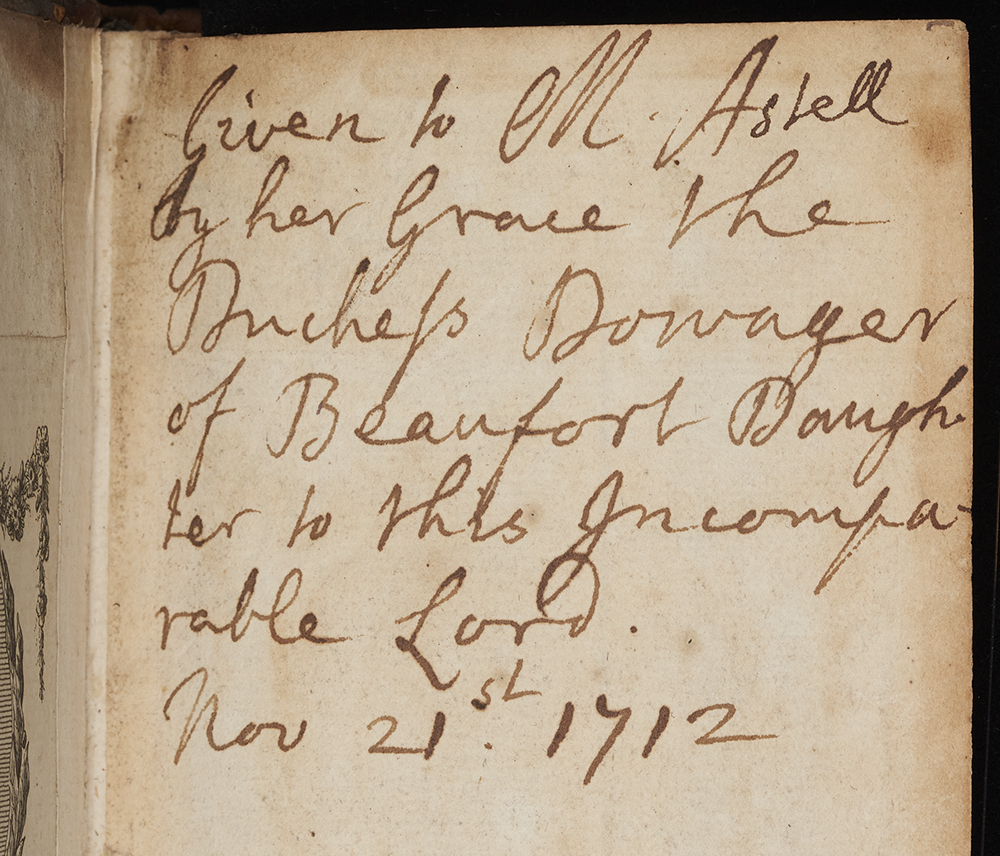
Sutherland says: “I love the inscriptions in the books which were gifted to Astell. These helped me find out more about her circle of friends and colleagues, and build up a picture of how she exchanged ideas with both male academics and like-minded women.”
Making her mark
Astell was an extensive annotator of her books, in their margins, endpapers and pastedowns. She used pen and pencil to make additions, deletions and substitutions but also wrote more interpretive comments in the larger blank spaces. She composed indices for her personal reference and made corrections to the printed text using errata slips.
Astell paid ten shillings for Descartes’ Les Principes de la Philosophie in 1695, the highest price she recorded and this book is the most heavily annotated in the collection. There are several extra blank pages bound into the volume to make space for her observations.
Her notes are a mixture of brief translations into English in the margins, her own responses to the text, cross-references to other works and copied and translated extracts from Baillet’s biography of Descartes. Her detailed notes relating to maths and science are particularly striking.
Astell studied astronomy with John Flamsteed between 1697 and 1698, and her notes in Les Principes demonstrate that she had already attained a high level of understanding in the sciences prior to her formal studies with the Astronomer Royal.
Dame Athene Donald, Professor of Experimental Physics at Cambridge says: “Astell’s annotations demonstrate that she had read and thought carefully about much of what Descartes had written, giving careful explanations in English of some of his ideas. She was not frightened of disagreeing with him either, with several examples of ‘false’ being written in the marginalia regarding his analysis of the laws of motion.
“Astell may not have read Isaac Newton’s Principia which gave more precise and quantitative laws. Newton’s Laws have stood the test of time unlike some propounded by Descartes, including the very ones Astell annotated with ‘false’. It is a key moment in a researcher’s development when they are first willing to say ‘I don’t believe this’. It is intriguing that she had that confidence, given her circumstances.
“Although she didn’t publish scientific works, her belief in education for girls and women – about which she did write – certainly would have allowed for the possibility of women tackling these subjects. In this she was way ahead of her time.
How did Magdalene come to own Astell’s books?
This remains something of a mystery but Sutherland has a convincing theory.
In the 1740s, it was rumoured that Astell left an extensive library to ‘Magdalen College’ on her death and, in the draft manuscript of Memoirs of Several Ladies of Great Britain, George Ballard stated that ‘She gave her library, which was a pretty large one to Magdalene College in Oxford’. Crucially, ‘in Oxford’ has been deleted, presumably because Ballard couldn’t find any evidence of Astell’s books at his own college: Magdalen, Oxford.
This mix-up is understandable since it was only in the nineteenth century that the final ‘e’ was added to the Cambridge college to better differentiate between the two, and any references to Magdalen prior to this without the suffix ‘Oxon’ or ‘Cant’ to guide the reader could refer to either college.
While Ballard seems to have realised his mistake, Astell’s bequest was cut from the published version of his book, which helps to explain why the collection has been overlooked for nearly 300 years. Intriguingly, however, Ballard’s note suggests that Astell made a deliberate decision to leave her library to the Cambridge college.
“Unfortunately, there is no documentary evidence of Astell’s books arriving at Magdalene”, Sutherland explains. “The only suggestion of a personal link between Astell and the college is that Daniel Waterland, theologian and Master between 1713 and 1740, cited Astell’s The Christian Religion, as Profess’d by a Daughter of the Church of England in his Advice to a Young Student. He called Astell an ‘ingenious lady’ and shared similar interests including Malebranche, Calamy and charity schools.”
During Astell’s later life, Magdalene was in a period of active book collecting. Waterland set up the Pepys Library at Magdalene when it arrived in 1724 and Astell may have been aware of this. The event was announced in newspapers, and Astell and Pepys had mutual acquaintances. It seems likely that Waterland took an interest in brokering donations of books to the college, especially from someone like Astell.
Unfinished business
Some of the books in the collection were purchased after Astell published her final work in 1709. It is possible that these books were bought for a future project - Astell intended to work with female friends on a compendium of natural philosophy written for women.
Although Astell made a habit of marking books, there are some books in Magdalene’s Old Library which are both rarities and highly relevant to Astell’s fields of interest so there may be more discoveries to come.
All images © Master and Fellows of Magdalene College Cambridge
